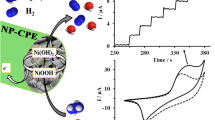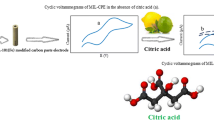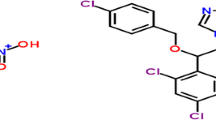Abstract
The potentiometric properties of all-solid-state nitrate-selective electrodes based on plasticized PVC and containing different types of nanosized carbon black were investigated. The use of a carbon black interlayer is shown to significantly improve the potentiometric response. The electrodes display a close-to-Nernstian slope in the range from 10−1 to 10−6 M, highly stable potentials and low membrane resistance. However, different analytical features were found depending on the type of carbon black used. The best long-term potential stability was observed for the electrode with Printex XE2-B carbon black that has a relatively high BET surface area (1000 m2 · g−1) and an average particle size of 30 nm. Nevertheless, the electrodes with the Vulcan XC-72 (BET surface: 240 m2 · g−1; average size: 55 nm) showed the most repeatable and reproducible standard potential. The lowest detection limit for nitrate (2.5·10−7 M) is observed for an electrode containing Vulcan XC-72.

The comparison of the potentiometric behavior of all-solid state ion-selective electrodes with the different types of the furnace carbon black is presented by employing the nitrate-selective membrane. The electrodes display a close-to-Nernstian slope, highly stable potentials and low membrane resistance







Similar content being viewed by others
References
Bobacka J, Ivaska A, Lewenstam A (2008) Potentiometric ion sensors. Chem Rev 108:329–351. doi:10.1021/cr068100w
Cattrall R, Freiser H (1971) Coated wire ion-selective electrodes. Anal Chem 43:1905–1906. doi:10.1021/ac60307a032
Bobacka J (2006) Conducting polymer-based solid-state ion-selective electrodes. Electroanalysis 18:7–18. doi:10.1002/elan.200503384
Wardak C, Lenik J (2013) Application of ionic liquid to the construction of Cu(II) ion-selective electrode with solid contact. Sensors Actuators B 189:52–59. doi:10.1016/j.snb.2012.12.065
Paczosa-Bator B, Cabaj L, Piech R, Skupień K (2012) Platinum nanoparticles intermediate layer in solid-state selective electrodes. Analyst 137:5272–5277. doi:10.1039/c2an35933b
Paczosa-Bator B, Cabaj L, Piech R, Skupień K (2013) Potentiometric sensors with carbon black supporting platinum nanoparticles. Anal Chem 85:10255–10261. doi:10.1021/ac402885y
Fouskaki M, Chaniotakis N (2008) Fullerene-based electrochemical buffer layer for ion-selective electrodes. Analyst 133:1072–1075. doi:10.1039/b719759d
Lai C, Fierke MA, Stein A, Bühlmann P (2007) Ion-selective electrodes with three-dimensionally ordered macroporous carbon as the solid contact. Anal Chem 79:4621–4626. doi:10.1021/ac070132b
Crespo GA, Macho S, Rius FX (2008) Ion-selective electrodes using carbon nanotubes as ion-to-electron transducers. Anal Chem 80:1316–1322. doi:10.1021/ac071156l
Zhu J, Qin Y, Zhang Y (2009) Preparation of all solid-state potentiometric ion sensors with polymer-CNT composites. Electrochem Commun 11:1684–1687. doi:10.1016/j.elecom.2009.06.025
Li F, Ye J, Zhou M, Gan S, Zhang Q, Han D, Niu L (2012) All-solid-state potassium-selective electrode using graphene as the solid contact. Analyst 137:618–623. doi:10.1039/c1an15705a
Paczosa-Bator B (2012) All-solid-state selective electrodes using carbon black. Talanta 93:424–427. doi:10.1016/j.talanta.2012.02.013
Paczosa-Bator B, Piech R, Cabaj L (2012) The influence of an intermediate layer on the composition stability of a polymeric ion-selective membrane. Electrochim Acta 85:104–109. doi:10.1016/j.electacta.2012.08.051
Ivanova NM, Podeshvo IV, Goikhman MY, Yakimanskii AV, Mikhelson KN (2013) Potassium-selective solid contact electrodes with poly(amidoacid) Cu(I) complex, electron-ion exchanging resin and different sorts of carbon black in the transducer layer. Sensors Actuators B 186:589–596. doi:10.1016/j.snb.2013.06.072
Degussa/Evonik, Germany - Pigmentrusse/pigment blacks, Technische Daten Europa/Technical Data Europe, Degussa AG, Advanced fillers & pigments (2006)
Williams M, Khotseng L, Naidoo Q, Petrik L, Nechaev A, Linkov V (2009) Applicability of analytical protocols for the characterisation of carbon-supported platinum group metal fuel cell electrocatalysts. S Afr J Sci 105:285–289
Tang W, Ping J, Fan K, Wang Y, Luo X, Ying Y, Wu J, Zhou Q (2012) All-solid-state nitrate-selective electrode and its application in drinking water. Electrochim Acta 81:186–190. doi:10.1016/j.electacta.2012.07.073
Bakker E, Pretsch E, Bühlmann P (2000) Selectivity of potentiometric ion sensors. Anal Chem 72:1127–1133. doi:10.1021/ac991146n
Fibbioli M, Morf WE, Badertscher M, De Rooij NF, Pretsch E (2000) Potential drifts of solid-contacted ion-selective electrodes due to zero-current ion fluxes through the sensor membrane. Electroanalysis 12:1286–1292. doi:10.1002/1521-4109(200011)12:16<1286::AID-ELAN1286>3.0.CO;2-Q
Bobacka J (1999) Potential stability of all-solid-state Ion-selective electrodes using conducting polymers as Ion-to-electron transducers. Anal Chem 71:4932–4937. doi:10.1021/ac990497z
Mousavi Z, Bobacka J, Lewenstam A, Ivaska A (2009) Poly(3,4-ethylenedioxythiophene) (PEDOT) doped with carbon nanotubes as ion-to-electron transducer in polymer membrane-based potassium ion-selective electrodes J. Electroanal Chem 633:246–252. doi:10.1016/j.jelechem.2009.06.005
Acknowledgement
The author is grateful to K. Skupień (3D-nano Co.) for stimulating discussion. This work was supported by NCBiR (No. LIDER/31/7/L-2/10/NCBiR/2011). W. Osiewala is acknowledged for improving the English text.
Author information
Authors and Affiliations
Corresponding author
Rights and permissions
About this article
Cite this article
Paczosa-Bator, B. Effects of type of nanosized carbon black on the performance of an all-solid-state potentiometric electrode for nitrate. Microchim Acta 181, 1093–1099 (2014). https://doi.org/10.1007/s00604-014-1216-7
Received:
Accepted:
Published:
Issue Date:
DOI: https://doi.org/10.1007/s00604-014-1216-7




